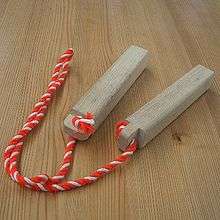Hyoshigi
 Hyoshigi | |
| Percussion Instrument | |
|---|---|
| Classification | Concussion Idiophone [1] |
| Other names | Concussion Blocks, Kabuki Blocks, Kabuki Clappers [2] |
The hyōshigi (拍子木) is a simple Japanese musical instrument, consisting of two pieces of hardwood or bamboo that are connected by a thin ornamental rope. The clappers are played together or on the floor to create a cracking sound. Sometimes they are struck slowly at first, then faster and faster.
Theater
Hyoshigi are used in traditional Japanese theaters, such as Kabuki and Bunraku theater, to announce the beginning of a performance.[1] The kyogen-kata usually plays the hyoshigi at the start of comedic plays.[3] It can be used to attract the attention of the audience by conductors for theater and even athletic and juggling performances.[4] Hyoshigi are also used to stress confusion [1] and other dramatic moments [5] in the play.
Religion
It is also often used to signal the starting or the end of parts of festivals, especially in the directing of the mikoshi.
Hyoshigi is combined with other traditional Japanese instruments in mikagur-auta, or cycle of songs, which is characteristic of the Tenrikyo religion.[6]
Other uses
The clapping instrument was also used in Kamishibai to gather children so that the Kamishibai man could sell candy and entertain them with his story.[7]
The wooden percussion instrument was also used by night-watchmen when patrolling the streets.[4]
References
- 1 2 3 Blades, James; Anderson, Robert. "Clappers". Grove Music Online. Oxford Music Online. Oxford University Press.
- ↑ James Holland (16 September 2005). Practical Percussion: A Guide to the Instruments and Their Sources. Scarecrow Press. ISBN 978-1-4616-7063-6.
- ↑ Saltzman-Li, Katherine (2010). Creating Kabuki Plays: Context for Kezairoku, Valuable Notes on Playwriting. Ipswich, MA: Leiden: Brill. p. 47. ISBN 9789004121157.
- 1 2 Sir Francis Taylor Piggott; Thomas Lea Southgate (1893). The Music and Musical Instruments of Japan. B.T. Batsford. p. 210.
- ↑ Karen Brazell (1998). Traditional Japanese Theater: An Anthology of Plays. Columbia University Press. p. 309. ISBN 978-0-231-10873-7.
- ↑ Kishibe, Shigeo; Hughes, David; de Ferranti, Hugh; Adriaansz, W.; Thompson, Robin; Rowe, Charles; Berger, Donald P.; Malm, W.; Waterhouse, David; Marett, Allan; Emmert, Richard; Koizumi, Fumio; Tanimoto, Kazuyuki; Kanazawa, Masakata; Fujie, Linda; Falconer, Elizabeth. "Japan". Grove Music Online. Oxford Music Online. Oxford University Press.
- ↑ De las Casas, Dianne; Chow, Philip (2006). Kamishibai Story Theater: The Art of Picture Telling. Westport, Conn: Teacher Ideas Press. p. 1. ISBN 9781591584049.